Screening for Chagas disease in Latin-American pregnant women and their newborns: A prospective observational, multicenter study in Milan, Italy
IF 4.7
3区 医学
Q1 INFECTIOUS DISEASES
引用次数: 0
Abstract
Objectives
Chagas Disease (CD), caused by Trypanosoma cruzi, is endemic in Latin America (LA). However, due to migration, it is now present globally. We aimed to evaluate the prevalence of CD among LA pregnant women in Milan, Italy, and the incidence of T. cruzi transmission to their newborns.
Methods
A prospective multicenter observational study was conducted in five different Obstetrics and Gynecology outpatient clinics in Milan, Italy between September 2019 and October 2024. Pregnant women from endemic areas for CD were tested by means of two serological tests directed against T. cruzi antigens. Newborns from positive T. cruzi mothers were screened for T. cruzi infection at birth and at 1, 3 and 9 months.
Results
339 women underwent screening for T. cruzi infection with a median age of 33 years [IQR 28–37 years]. Most of them came from Peru (38.3 %), followed by El Salvador (20.6 %) and Ecuador (19.5 %). Six of them tested positive for T. cruzi, accounting for an estimated prevalence of 1.77 % (95 % CI 0.37 %–3.17 %). Two of the affected women were from Bolivia, and the remaining from El Salvador, Brazil, Ecuador and Peru. All 6 children had a negative PCR for T. cruzi infection, and their serology turned negative within the first year of life.
Conclusions
The seroprevalence of T. cruzi infection among LA pregnant women in Milan is significant, underscoring the potential occurrence of congenital CD in a non-endemic area like Italy. Raising awareness of this neglected tropical disease among LA women, midwives and gynecologists is crucial.
拉丁美洲孕妇及其新生儿查加斯病筛查:意大利米兰的一项前瞻性观察性多中心研究
目的查加斯病(chagas Disease, CD)是由克氏锥虫引起的拉丁美洲流行疾病。然而,由于移民,它现在是全球性的。我们的目的是评估意大利米兰LA孕妇的乳糜泻患病率,以及克氏锥虫传播给新生儿的发生率。方法于2019年9月至2024年10月在意大利米兰5家不同妇产科门诊进行前瞻性多中心观察性研究。采用两种针对克氏锥虫抗原的血清学检测方法对来自CD流行地区的孕妇进行检测。克鲁氏锥虫阳性母亲的新生儿在出生时以及1、3和9个月时接受克鲁氏锥虫感染筛查。结果339名女性接受克氏弓形虫感染筛查,中位年龄33岁[IQR 28-37岁]。其中大部分来自秘鲁(38.3%),其次是萨尔瓦多(20.6%)和厄瓜多尔(19.5%)。其中6人克氏体检测呈阳性,估计患病率为1.77% (95% CI 0.37% - 3.17%)。其中两名受影响的妇女来自玻利维亚,其余来自萨尔瓦多、巴西、厄瓜多尔和秘鲁。6例患儿克氏体感染PCR均为阴性,1岁以内血清学转为阴性。结论米兰地区LA孕妇克氏体感染的血清阳性率显著,提示先天性CD在意大利等非流行地区可能发生。提高洛杉矶妇女、助产士和妇科医生对这种被忽视的热带病的认识至关重要。
本文章由计算机程序翻译,如有差异,请以英文原文为准。
求助全文
约1分钟内获得全文
求助全文
来源期刊

Travel Medicine and Infectious Disease
PUBLIC, ENVIRONMENTAL & OCCUPATIONAL HEALTH-INFECTIOUS DISEASES
CiteScore
19.40
自引率
1.70%
发文量
211
审稿时长
49 days
期刊介绍:
Travel Medicine and Infectious Disease
Publication Scope:
Publishes original papers, reviews, and consensus papers
Primary theme: infectious disease in the context of travel medicine
Focus Areas:
Epidemiology and surveillance of travel-related illness
Prevention and treatment of travel-associated infections
Malaria prevention and treatment
Travellers' diarrhoea
Infections associated with mass gatherings
Migration-related infections
Vaccines and vaccine-preventable disease
Global policy/regulations for disease prevention and control
Practical clinical issues for travel and tropical medicine practitioners
Coverage:
Addresses areas of controversy and debate in travel medicine
Aims to inform guidelines and policy pertinent to travel medicine and the prevention of infectious disease
Publication Features:
Offers a fast peer-review process
Provides early online publication of accepted manuscripts
Aims to publish cutting-edge papers
 求助内容:
求助内容: 应助结果提醒方式:
应助结果提醒方式:


